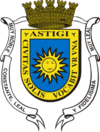Écija
| Ecija municipality | ||
|---|---|---|
| coat of arms | Map of Spain | |

|
|
|
| Basic data | ||
| Autonomous Community : | Andalusia | |
| Province : | Seville | |
| Coordinates | 37 ° 32 ′ N , 5 ° 5 ′ W | |
| Height : | 100 msnm | |
| Area : | 976 km² | |
| Residents : | 39,873 (Jan 1, 2019) | |
| Population density : | 40.85 inhabitants / km² | |
| Postal code : | 41400 | |
| Municipality number ( INE ): | 41039 | |
| administration | ||
| Mayor : | Juan Wic Morals | |
| Website : | www.ecija.es | |
Écija , the city of towers , is located on the Río Genil between the two Andalusian metropolises Córdoba and Seville in the province of Seville . The city is nicknamed La sartén de Andalucía (frying pan of Andalusia) .
History and archeology
A permanent settlement of Écija could be proven up to the eighth century BC. The Roman name of the Iberian settlement was Astigi . During the Battle of Munda , which was fought near Astigi, the city “stood firm” on Julius Caesar's side . Caesar rewarded the city with fortifications and re-established it as the Julian colony Colonia Iulia Firma Astigitana . Under Emperor Augustus , her name was expanded to Colonia Iulia Augusta Firma Astigitana . Under Augustus , Astigi, on the Roman road , also became the capital of one of the four convents of the Roman province of Baetica (the others were Gades , Hispalis and Corduba ). The legend tells of a stay of the apostle Paul in Astigi, who is said to have preached there. In late antiquity the city became a bishopric . Under the Visigoths , Astigi became a fortress . After the battle of the Río Guadalete in July 711 against the Moors , in which the Visigoth king Roderich fell, Écija was one of the first cities to be conquered by the Muslims and incorporated into their new province of al-Andalus . At first parts of the defeated Visigoth army had withdrawn here. Archaeological finds show that the city was then only a fraction of its ancient Roman size and that old Roman baths that were excavated in the town hall square of Écija ( Plaza de España or, more popularly, Salón de Écija ), in Visigothic and early Islamic times as Cemetery were used.
After the collapse of the Caliphate of Cordoba , Medina Astiğğia became dependent on various Taifa kingdoms , first the Birzalids of Carmona , then the Zirids of Granada and finally the Abbadids of Seville.
Ferdinand III. conquered the city in 1240 from the Almohads ( Reconquista ). In the centuries that followed, Écija developed into the “city of towers” through the building of churches.
The great earthquake of 1755 destroyed a large area of Écija.
sons and daughters of the town
- Garci Sánchez de Badajoz (around 1450–1460 – around 1526), Spanish song writer and musician
Footnotes
- ↑ Cifras oficiales de población resultantes de la revisión del Padrón municipal a 1 de enero . Population statistics from the Instituto Nacional de Estadística (population update).
- ↑ http://www.revistaiberica.com/ecija-la-sarten-de-andalucia/
- ↑ firmam ; CIL 02-05, * 00057.
-
↑ In the Alcázar of Écija an inscription was found that honors Écija's role in the Battle of Munda: “Emperor Gaius Iulius Caesar, who defeated the son of Pompey in the Battle of Munda, fortified the colony under her name Iulia Augusta Firma Astigitana, for it was well deserved, and repaired its walls. ”(A copy of the inscription was excavated in Osuna ; CIL 02-05, * 00057 = CILA 02-04, * 00029.) The word AVG [usta (m)] in the name of the Colony referring to the Emperor Augustus was added to the inscription later (cf. Vicente Duran Recio, La Batalla de Munda , Córdoba 1984, p. 15 ff.). Latin text:
C [aius] IVLIVS CAESAR IMP [erator]
VICTO AD MVNDAM F [ilio] POMP [ei]
ASTIGITAN [am] COLON [iam] SVI NOM [inis] IVL [iam] ·
AVG [ustam] · FIR [mam] · DE · SE · MER [itam] · COMMVNIVIT ·
ET · MVROS · REPAR [avit] ·.





